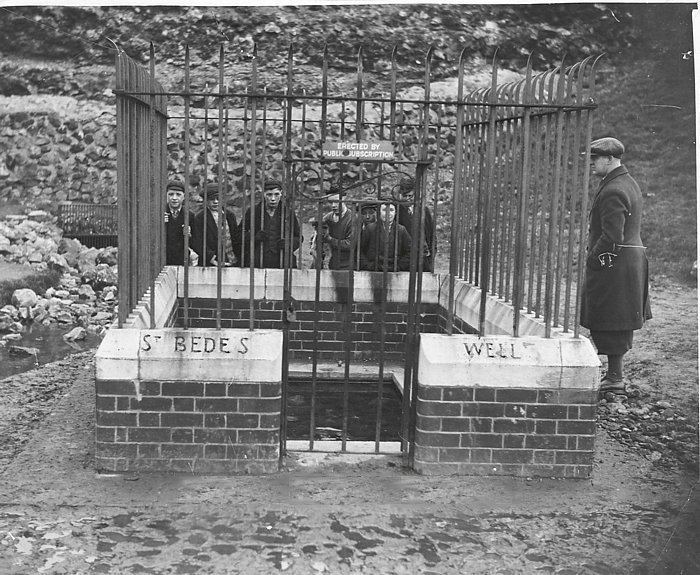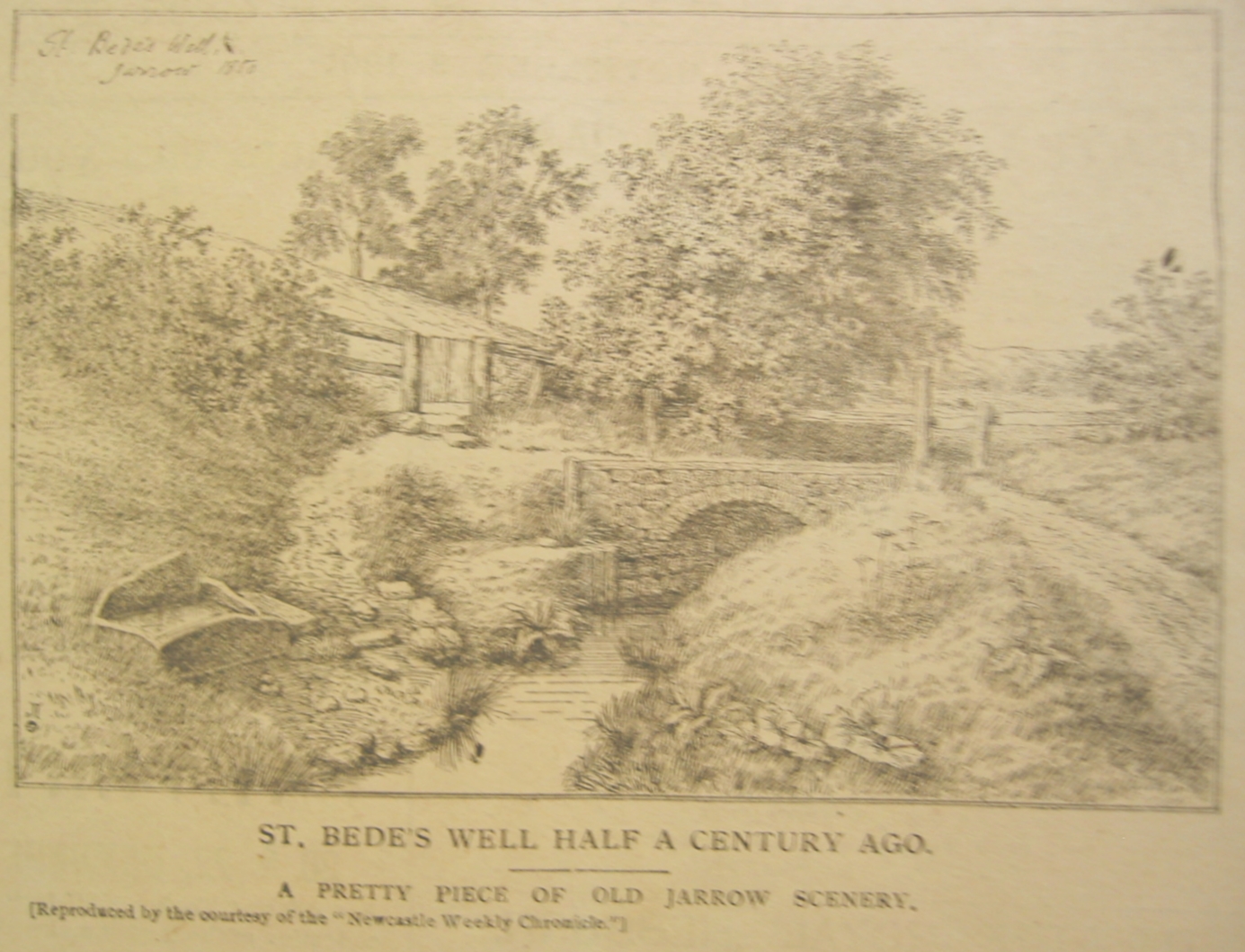
Any child brought up in Jarrow or Hebburn prior to the 1970's would have heard of Saint Bede's Well. By the mid-fifties, when I first became acquainted with it, it was still in a reasonable state. It stood on the southern bank of the Bede Burn, beside an ancient footpath leading from Hebburn Red House to Monkton Village, and was overshadowed by the enormous Slag Heap which, in its own way, was also a Jarrow monument.
The "Well", at that time, consisted of a square of brickwork topped off with coping stones and enclosed by iron railings, very much as in the 1932 picture below, although the railings and stonework were not in as good condition. The picture is looking eastwards, and on the left hand side one can see the iron grating where the Bede Burn disappeared under the Slag Heap, to re-appear in Pigsty Avenue in Jarrow.

As children, we believed that the railings were there to stop us getting in and falling down the well. As we grew older and more venturesome, we climbed over, and found that inside was actually solid ground - no trace of a well at all. In fact the whole structure was an Edwardian folly, placed there in 1908 by well-meaning citizens who were concerned that this shrine to Jarrow's favourite (and only) Saint, had become derelict. Before Palmer's Ironworks began tipping slag into the Bede Burn valley, eventually filling it up completely, the area had looked much more picturesque, as shown in the engraving below, taken from the Jarrow Guardian in 1908.

This picture is looking westwards, towards the site of present-day Campbell Park Road. It has undoubtedly been subject to a certain amount of artistic licence; the following postcard, dated 1908, shows much the same scene, but the bridge is a more utilitarian structure.

The following photograph is from a postcard dated 1910; in this case the view is towards the east, and the encroachment of the slag heap can be seen in the background. The postcard was printed for Pescod, a stationer in Jarrow at the time. The same view appears on a Lindsay series postcard posted in 1915.

It was around 1908 that certain local citizens began to get concerned about the state of this relic, as the growing heap of slag from Palmers blast furnaces threatened to inundate it. An appeal was launched in the columns of the Jarrow Guardian to raise funds for its preservation. This attracted a number of generous donations, but nothing happened for many years, as shown in the photograph below dated 1928. Eventually however the structure shown in the 1932 photograph was erected.


The generally accepted legend concerning St Bede's Well was that the Saint himself had drawn water from it as a boy in Monkton, and in his later years as a priest at St Paul's Monastery he would send the monks to this very well to fetch water. It was a pleasant story, but it had a number of flaws:
1. St Bede did not reveal the place of his birth; in his writings all he reveals is that he was born "on the lands of this monastery".
2. There was no need for the monks of St Paul's to journey to Monkton for water; there was a well within the the monastic grounds which can be seen to this day.
3. To dig a well requires the expenditure of a lot of time and effort; why would someone dig a well only four feet from a source of perfectly fresh water? Even in the 1960's the Bede Burn supported pollution-intolerant species such as freshwater crayfish and water scorpions. In Bede's time it would have been even cleaner, if anything.
4. There is no evidence of a well under the structure. During the 1960's the pupils of Jarrow Central School carried out a dig inside the railed-in area, and none of them fell though.
The subject recently came up for discussion on the Hebburn Website Message Board, and an interesting observation was made by one of the contributors, username May. She pointed out that the "Bede" in Bede's Well might be derived, not from the Saint's name, but from the Anglo-Saxon word "Bæð" meaning a bathing-place. This certainly would match up with the 1858 and 1908 pictures, in which the so-called well looks more like a horse-trough into which water from the stream might be tipped for washing purposes. This does not entirely rule out, however, the possibility that the site originally had a religious or semi-religious significance, as the word "Bæð" can also mean a medicinal spring - the city of Bath gets its name from this. It is worth noting in this context that several of the images do give the impression that water is flowing from the well site into the adjacent stream. To my mind either of these two possibilities seems more convincing than the legend I absorbed as a child. It also raises another interesting possibility - did the "Clegg" well in Hebburn also have an Anglo-Saxon origin? The Anglo-Saxon word "Clæg" means clay, from which we derive the delightful Geordie expression "claggy". Was the Clegg well near to or associated with a claypit?

The enthusiasm of the Edwardians towards the preservation of St Bede's Well was not matched by later generations, and by 1973 it was looking very sorry indeed, as shown in the picture below. The brickwork was still there, but the coping stones and railings had disappeared. One wonders if the engraved stones are preserved in some Jarrow garden?

When the Slag Heap was finally removed the whole area was given a makeover. The site of the well was paved and park benches provided. As with all such schemes, the need for security and maintenance was not considered, and the area quickly became rundown. The final photograph below shows the site as it is in 2006.

![]()